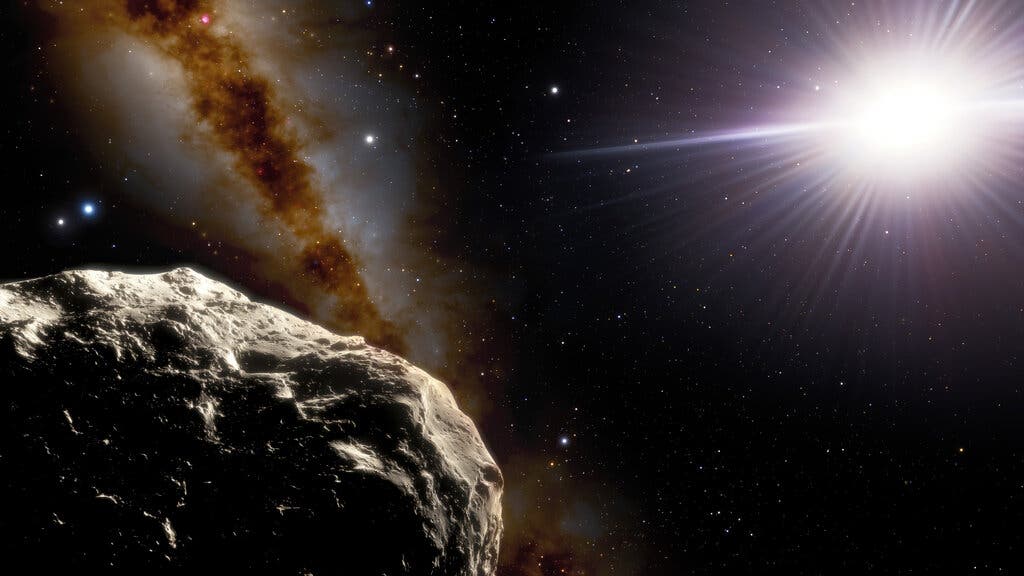Astronomers have identified an asteroid that is trapped in Earth’s orbit and shadowing the planet.
The asteroid, known as 2020 XL5, is just the second of its kind to be discovered, shepherded into an orbit that is perfectly aligned with that of our planet by the gravity of the planet itself. It hasn’t been in our orbit for very long – maybe a few millennia at the most. And it is not going to be there in the foreseeable future. 2020 XL5 is predicted to slip from of Earth’s hold in 4,000 years and make its way towards the rest of the solar system, according to simulations.
However, the fact that it exists provides a tantalising peek of what else may be lurking in the gravitational whirlpools in the vicinity. Some of the pieces might be as old as the solar system itself, and they could represent shades of the building blocks that eventually became our planet.
In a report detailing the finding, published on Tuesday in the journal Nature Communications, Toni Santana-Ros, a postdoctoral researcher at the University of Barcelona in Spain and an author of the publication, said: “These items are not as strange as we assume.” The findings of a different team of astronomers in December came to a similar conclusion.
It is known that when two objects circle each other, there are five locations in the orbit known as Lagrange points where the gravitational pulls of the two objects are almost equal, and a much smaller mass may sit at one of these points in equilibrium. Two of the five Lagrange points, referred to as L4 and L5, are considered to be stable: If a tiny body is shifted slightly in that direction, it will stay at that location. A little shove at each of the three unstable Lagrange points — L1 through L3 — will be sufficient to drive the tiny body away for good.
Max Wolf, a German astronomer who pioneered the use of photographic techniques to identify asteroids, discovered an asteroid in 1906 that had the same orbit as Jupiter, but was always 60 degrees ahead of the planet, or one-sixth of an orbit, from the planet. Later astronomers discovered more asteroids at or around the same location, as well as asteroids that trailed Jupiter by the same margin as the original discovery.
Interestingly, this corresponds to a prediction made by mathematician Jose-Louis Lagrange more than a century before. Astronomers began naming these bodies after heroes from the Trojan War, and the bodies came to be known as the Trojan asteroids as a result of this practise.
It seems that many of Jupiter’s more than 11,000 Trojans were created during the solar system’s birth and are hence primordial leftovers. A NASA spacecraft dubbed Lucy, named after a fossilised skeleton of an early human ancestor, was launched in October to explore a number of these locations.
Similar asteroids seem to be stuck in the orbits of Venus, Mars, Uranus, and Neptune, and their orbits are similar to each other. None have been discovered in the orbits of Saturn or Mercury, where any small Trojans would be almost hard to detect because to the brightness of the sun. The disruptive gravity of Jupiter is suspected to be the cause of the lack of discovery in these orbits.
As with Trojan asteroids, the Earth looked to be devoid of them until an astronomer discovered one in 2010 near the Lagrange point L4, 60 degrees ahead of the planet. Further investigations yielded up nothing until Pan-Starrs, an automated sky survey in Hawaii, discovered an interesting object called 2020 XL5, which seemed to be imprisoned around the L4 nebula as well.
However, the early observations were inadequate to determine the object’s orbit with any degree of certainty. In 2021, a multinational team of astronomers led by Dr. Santana-Ros saw the comet 2020 XL5 with three ground-based observatories, providing more evidence of its existence. The crew was subsequently able to scan through photographs going back to 2012, which revealed that the asteroid had really emerged, despite the fact that no one had identified it as an asteroid at the time.
The elliptical orbit of 2020 XL5 was ultimately securely established after a decade of data collection. According to Dr. Santana-Ros, they were “100 percent certain” that they were dealing with an Earth Trojan.
2020 XL5 is locked in an orbit around a stable Lagrange point, however it is not especially near to the Lagrange point L4 because of its orbit. Its eccentric orbit, which is inclined almost 14 degrees relative to the planets’ orbits, takes it closer to the sun than Venus and almost as far out as Mars, depending on the time of year.
As a result, it is particularly sensitive to gravitational buffeting from other planets, particularly Venus.
2020 XL5 seems to be a black, carbon-rich object, maybe an intruder from the main asteroid belt between Mars and Jupiter, based on its appearance. The researchers estimate its diameter to be around three-quarters of a mile, making it far bigger than the Earth Trojan identified in 2010, which was thought to be approximately a quarter-mile in diameter and was likewise discovered in the L4 Lagrange point.
Other bodies that hover closer to the stable Lagrange points, in contrast to the two known Earth Trojans, might stay in place eternally, boosting the prospect that some of the Earth’s original building components could still be discovered in that region.
“All of the formation models give you the impression that planets should have these families going around their L4 and L5 points from the beginning,” said Federica Spoto, an astronomer at the Center for Astrophysics in Cambridge, Massachusetts, who was not involved with the research.
“If we were able to locate anything like that, we may be able to figure out what occurred at the beginning, in general,” she said.

